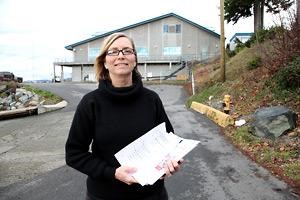City of Powell River Council has ruled out co-treatment of liquid waste using Catalyst Paper Corporation’s treatment plant.
Instead, the city will pursue a standalone, consolidated plant to be located in the Townsite solely owned by the city.
At its Thursday, February 5, meeting, council carried a motion that specifies calling a town hall meeting to complete the public consultation plan; and update the liquid waste management plan (LWMP) for submission to the ministry of environment, removing co-treatment as an option, and including only a publicly-owned and operated, technologically and / or environmentally innovative consolidated standalone facility as the option. The motion was not unanimous, with Councillor Jim Palm opposed.
The motion carried at council was a modification of a recommendation that came from the city’s liquid waste management steering committee two days before, which called for the LWMP to be updated for submission to the ministry. That recommendation contained options for co-treatment and consolidated plants.
There are nine voting members of the committee and four councillors: Karen Skadsheim, Rob Southcott, CaroleAnn Leishman and Russell Brewer, opposed the recommendation going to council. However, at the seven-member council table, the four held sway and gained support from Mayor Dave Formosa and Councillor Maggie Hathaway to endorse the motion calling for a consolidated plant.
Brewer advocated looking at the waste transfer site, where the city’s old incinerator was located, but that option was taken off the table, given that the plan to be submitted to the province specifies Townsite as the treatment plant’s location.
At city council, Skadsheim, who had chaired the liquid waste steering committee meeting, expressed concerns about the committee recommendation.
“I still feel there are a lot of unanswered questions and risks involved with co-treatment,” she said.
Skadsheim then introduced the revised recommendation as a motion, removing co-treatment as an option.
Leishman said there have been several letters and emails since the meeting on Tuesday expressing concern and opposition to the co-treatment option.
Hathaway reminded council that the committee had recommended co-treatment and a standalone facility and the motion brought from the committee was to make sure there was the option of either co-treatment or standalone. She said if the liquid waste plan was sent to the government for approval with both options, the city could opt for either.
“I would like to take that to the public,” Hathaway said.
Brewer said it is clear that the public does not favour co-treatment. He added that co-treatment is fraught with risks and uncertainty that he’s concerned will cost more than a consolidated plan in the long run. “I think we need to choose the consolidated option and start applying for funding.”
Palm expressed concern that changing direction would turn back the clock six years if the original motion was turned down and the plan was not submitted to government.
Brewer said if the plan was amended to specify a consolidated plant owned by the city, it would be no different than submitting a plan for co-treatment. He said the plan could be revised with consolidated as the option. He said it would not be setting anything back. It would just remove co-treatment as an option.
Formosa said he had asked Mac Fraser, the city’s chief administrative officer, if consolidated treatment was substituted for co-treatment, whether the city would have to go back to step one. Formosa said he was told that the belief is that as long as the siting of the treatment plant is in Townsite, the city could move forward with a consolidated treatment plant.
Hathaway asked if the ministry was to give approval to the plan, whether the city would be ready to go ahead with a consolidated facility. Fraser said the draft plan specifies both options in Townsite. Submitting a plan with collection and treatment at another site would require re-engineering.
Formosa said he’d like to get on with it and the waste transfer site is off the table. He said the costs would be significantly higher at that site.



